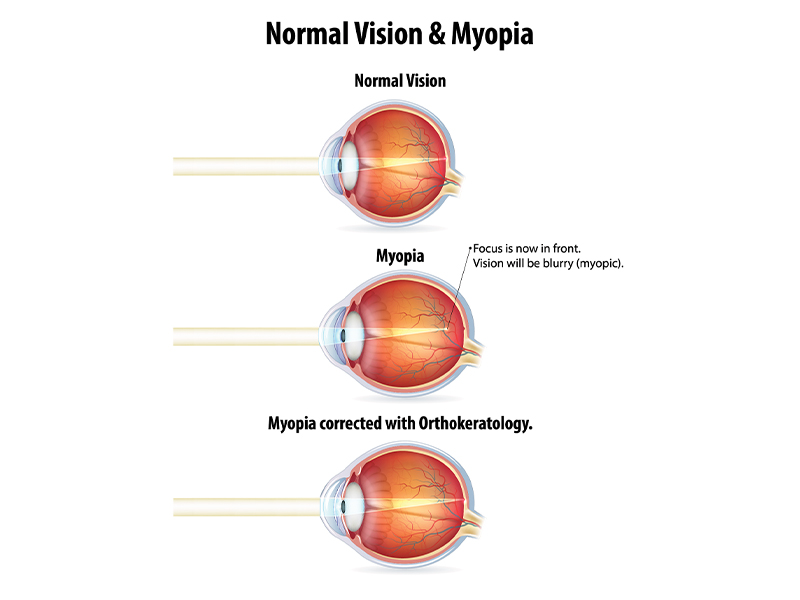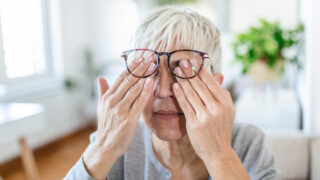Not exactly new, the exciting science of orthokeratology now promises an end to spectacles (or contact lenses) for children and adults with myopia or farsightedness.
What is orthokeratology, or ortho-k?
Briefly, it’s the use of gas-permeable contact lenses that temporarily reshape the cornea overnight to reduce myopia (short-sightedness), hyperopia (far-sightedness) and astigmatism. The amazing effect is that you can then go a whole day, or even longer, without spectacles or contact lenses.
How is it possible that I’m hearing of this for the first time? As a myopic someone who’s always on the lookout for alternative health options, why had I never heard of a treatment that has its origins over 60 years ago? It’s a puzzle.
But now that I do know about it, I think everyone else should too.
I myself was diagnosed as an eight year-old with fairly advanced myopia (near-sightedness), and went through the whole sad childhood circus of increasingly thick spectacles, then teenage contact lenses – hard, semirigid impermeable, soft and eventually disposable – before undergoing LASIK surgery in Singapore in my forties.
And now, it breaks my heart to see our eight- and 12-year-old granddaughters, Mia and Holly, being fitted for their own ever-stronger glasses. They don’t seem too fazed, however. Young Holly has a fascination bordering on obsession with anything even vaguely medical, and couldn’t wait to choose her new spec frames.
To be clear (pun intended), ortho-k is not the only alternative to conventional glasses. Another option is myopia control spectacle lenses using DIMS technology. Fortunately for Mia and Holly, they’re approved for children aged eight to 13 and are available not only in Singapore, but also in Australia.
What’s wrong with specs?
Choosing conventional spectacles for myopia may be a short-sighted decision (sorry). While vision health practitioners may not always admit it, prescribing spectacles for myopia starts a progressive deterioration calling for increasingly stronger prescriptions.
Optometrist Brian Chung absolutely agrees: “A normal concave lens is bound to cause myopia to progress, because of peripheral defocus,” he explains.
Brian was one of the first optometrists in Singapore to provide orthokeratology, and is a strong advocate of the technique. In fact, his clinic, AeroV, has successfully used it to treat over a thousand children alone.
Apparently, the rate of myopia in Singapore has quadrupled since the 1960s, and it’s estimated that by 2050 one in every two children will be near-sighted, and one in ten severely near-sighted. In response, the school curriculum here has been changed to allow children to spend more time outdoors.
Why the increase?Because we all spend far more time indoors than we used to, and close-up indoor activities, including reading and screen-time, are a sure-fire recipe for myopia in children.
“Genetics also plays a part,” he says. So does epigenetics, adding fuel to the fire. “If both parents are myopic, their children are very likely to be myopic too.”
Long-term dangers of myopia
“We started specialising in ortho-k way before the boom,” he says, “because we knew the importance of myopia control.” It’s not only about appearance and lifestyle, either. Importantly, it also affects our lifelong vision and ocular health.
That’s because severe myopia is associated with eye disease and loss of vision later in life. “For example, a child with myopia greater than -5.00 diopters has a shocking 60 times greater risk of developing retinal degeneration in adulthood.”
History of ortho-k
• First created in the 1960s by George Jessen, the early glass lenses had unpredictable results.
• In the 1990s, computerised corneal topography enabled safe, painless and accurate mapping of the cornea’s surface curvature, making the treatment customisable for general use. New base materials, like those used for gas-permeable rigid contact lenses, also meant they could be used overnight. And computer-controlled precision lathes meant that manufacture became commercially viable.
• The first US approval for an overnight corneal reshaping lens, the CRT, was granted only in 2002, a good 15 years after some European countries had approved it.
• Today, there are orthokeratology associations in many regions, including America, the UK and Australia.
Q&A with Brian Chung
Is orthokeratology widely available in Singapore?
More optometrists are starting to offer it, but most of them use mass-produced lenses. For whatever reason, Singapore ophthalmologists tend not to offer it. That’s despite extensive research – showing good results – published in many established scientific journals.
Who is orthokeratology for?
Anyone who wants corrected vision that doesn’t involve surgery, glasses or daytime contact lenses. In fact, it’s suitable for a surprisingly wide range of subjects of all ages and stages of vision impairment.
Usually, the mass-manufactured lenses are limited with regard to the severity of myopia they can treat, for example, up to -5.00 diopters. But with our fully customised ortho-k treatment, we craft lenses that have successfully corrected up to -12.00 of myopia and -6.00 of astigmatism.
Apart from preventing most myopia cases from worsening, have you seen cases where ortho-k actually reverses nearsightedness?
Yes, but only a handful. Imagine a bell curve: a few achieve long-term myopia improvement, and a few continue to deteriorate.
Can ortho-k be used for someone who, like me, previously underwent LASIK surgery and is now developing presbyopia?
Yes, you could be a candidate. But only for the fully customised ortho-k that we offer, because we build the lenses according to your corneal shape.
There’s no upper age limit for ortho-k, but the objective is totally different. For children, we aim for both myopia control and vision correction; for adults, only vision correction. When you add presbyopia into the equation it gets more tricky, but it still can be done.
Your work sounds so rewarding – is it?
It definitely is! I have friends living with -10.00 diopters of myopia, just because their parents didn’t know it could be controlled. So, helping children to prevent that is highly satisfying!
AeroV – Your Trusted Optometrists
#01-18 Sin Ming Plaza, 6 Sin Ming Road
9858 1308 | aerov.com.sg
This article first appeared in the January 2023 edition of Expat Living. You can purchase the latest issue or subscribe, so you never miss a copy!
To make the most of living in Singapore, read our latest City Guide here for free!









